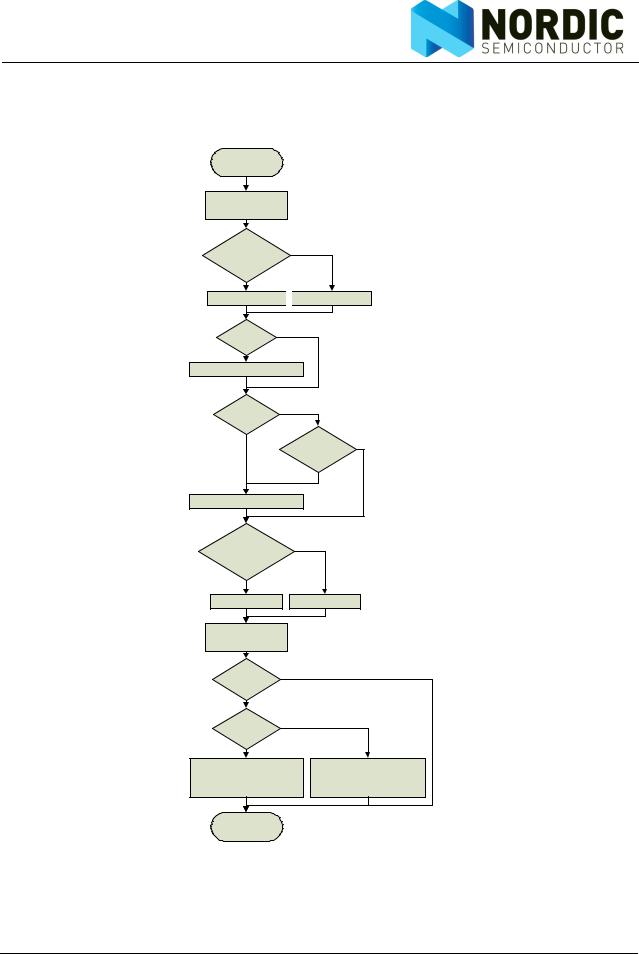
- •1 Introduction
- •1.1 Features
- •1.2 Block diagram
- •2 Pin Information
- •2.1 Pin assignment
- •2.2 Pin functions
- •3 Absolute maximum ratings
- •4 Operating conditions
- •5 Electrical specifications
- •5.1 Power consumption
- •5.2 General RF conditions
- •5.3 Transmitter operation
- •5.4 Receiver operation
- •5.5 Crystal specifications
- •5.6 DC characteristics
- •5.7 Power on reset
- •6 Radio Control
- •6.1 Operational Modes
- •6.1.1 State diagram
- •6.1.2 Power Down Mode
- •6.1.3 Standby Modes
- •6.1.4 RX mode
- •6.1.5 TX mode
- •6.1.6 Operational modes configuration
- •6.1.7 Timing Information
- •6.2 Air data rate
- •6.3 RF channel frequency
- •6.4 Received Power Detector measurements
- •6.5 PA control
- •6.6 RX/TX control
- •7 Enhanced ShockBurst™
- •7.1 Features
- •7.2 Enhanced ShockBurst™ overview
- •7.3.1 Preamble
- •7.3.2 Address
- •7.3.3 Packet control field
- •7.3.3.1 Payload length
- •7.3.3.2 PID (Packet identification)
- •7.3.4 Payload
- •7.3.5 CRC (Cyclic Redundancy Check)
- •7.3.6 Automatic packet assembly
- •7.3.7 Automatic packet disassembly
- •7.4 Automatic packet transaction handling
- •7.4.1 Auto acknowledgement
- •7.4.2 Auto Retransmission (ART)
- •7.5 Enhanced ShockBurst flowcharts
- •7.5.1 PTX operation
- •7.5.2 PRX operation
- •7.8.1 Single transaction with ACK packet and interrupts
- •7.8.2 Single transaction with a lost packet
- •7.8.3 Single transaction with a lost ACK packet
- •7.8.4 Single transaction with ACK payload packet
- •7.8.5 Single transaction with ACK payload packet and lost packet
- •7.8.6 Two transactions with ACK payload packet and the first ACK packet lost
- •7.8.7 Two transactions where max retransmissions is reached
- •7.9 Compatibility with ShockBurst™
- •7.9.1 ShockBurst™ packet format
- •8 Data and Control Interface
- •8.1 Features
- •8.2 Functional description
- •8.3 SPI operation
- •8.3.1 SPI commands
- •8.3.2 SPI timing
- •8.4 Data FIFO
- •8.5 Interrupt
- •9 Register Map
- •9.1 Register map table
- •10 Peripheral RF Information
- •10.1 Antenna output
- •10.2 Crystal oscillator
- •10.3 nRF24L01+ crystal sharing with an MCU
- •10.3.1 Crystal parameters
- •10.3.2 Input crystal amplitude and current consumption
- •10.4 PCB layout and decoupling guidelines
- •11 Application example
- •11.1 PCB layout examples
- •12 Mechanical specifications
- •13 Ordering information
- •13.1 Package marking
- •13.2 Abbreviations
- •13.3 Product options
- •13.3.1 RF silicon
- •13.3.2 Development tools
- •14 Glossary of Terms
- •Appendix A - Enhanced ShockBurst™ - Configuration and communication example
- •Enhanced ShockBurst™ transmitting payload
- •Enhanced ShockBurst™ receive payload
- •Appendix B - Configuration for compatibility with nRF24XX
- •Appendix C - Constant carrier wave output for testing
- •Configuration

nRF24L01+ Product Specification
7.3.3.1Payload length
This 6 bit field specifies the length of the payload in bytes. The length of the payload can be from 0 to 32 bytes.
Coding: 000000 = 0 byte (only used in empty ACK packets.) 100000 = 32 byte, 100001 = Don’t care.
This field is only used if the Dynamic Payload Length function is enabled.
7.3.3.2PID (Packet identification)
The 2 bit PID field is used to detect if the received packet is new or retransmitted. PID prevents the PRX device from presenting the same payload more than once to the receiving host MCU. The PID field is incremented at the TX side for each new packet received through the SPI. The PID and CRC fields (see section 7.3.5 on page 30) are used by the PRX device to determine if a packet is retransmitted or new. When several data packets are lost on the link, the PID fields may become equal to the last received PID. If a packet has the same PID as the previous packet, nRF24L01+ compares the CRC sums from both packets. If the CRC sums are also equal, the last received packet is considered a copy of the previously received packet and discarded.
7.3.3.3No Acknowledgment flag (NO_ACK)
The Selective Auto Acknowledgement feature controls the NO_ACK flag.
This flag is only used when the auto acknowledgement feature is used. Setting the flag high tells the receiver that the packet is not to be auto acknowledged.
On the PTX you can set the NO_ACK flag bit in the Packet Control Field with this command:
W_TX_PAYLOAD_NOACK
However, the function must first be enabled in the FEATURE register by setting the EN_DYN_ACK bit. When you use this option the PTX goes directly to standby-I mode after transmitting the packet. The PRX does not transmit an ACK packet when it receives the packet.
7.3.4Payload
The payload is the user defined content of the packet. It can be 0 to 32 bytes wide and is transmitted on-air when it is uploaded to nRF24L01+.
Enhanced ShockBurst™ provides two alternatives for handling payload lengths; static and dynamic.
The default is static payload length. With static payload length all packets between a transmitter and a receiver have the same length. Static payload length is set by the RX_PW_Px registers on the receiver side. The payload length on the transmitter side is set by the number of bytes clocked into the TX_FIFO and must equal the value in the RX_PW_Px register on the receiver side.
Dynamic Payload Length (DPL) is an alternative to static payload length. DPL enables the transmitter to send packets with variable payload length to the receiver. This means that for a system with different payload lengths it is not necessary to scale the packet length to the longest payload.
Revision 1.0 |
Page 29 of 78 |

nRF24L01+ Product Specification
With the DPL feature the nRF24L01+ can decode the payload length of the received packet automatically instead of using the RX_PW_Px registers. The MCU can read the length of the received payload by using the R_RX_PL_WID command.
Note: Always check if the packet width reported is 32 bytes or shorter when using the R_RX_PL_WID command. If its width is longer than 32 bytes then the packet contains errors and must be discarded. Discard the packet by using the Flush_RX command.
In order to enable DPL the EN_DPL bit in the FEATURE register must be enabled. In RX mode the DYNPD register must be set. A PTX that transmits to a PRX with DPL enabled must have the DPL_P0 bit in DYNPD set.
7.3.5CRC (Cyclic Redundancy Check)
The CRC is the mandatory error detection mechanism in the packet. It is either 1 or 2 bytes and is calculated over the address, Packet Control Field and Payload.
The polynomial for 1 byte CRC is X8 + X2 + X + 1. Initial value 0xFF.
The polynomial for 2 byte CRC is X16+ X12 + X5 + 1. Initial value 0xFFFF.
The number of bytes in the CRC is set by the CRCO bit in the CONFIG register. No packet is accepted by Enhanced ShockBurst™ if the CRC fails.
Revision 1.0 |
Page 30 of 78 |

nRF24L01+ Product Specification
7.3.6Automatic packet assembly
The automatic packet assembly assembles the preamble, address, packet control field, payload and CRC to make a complete packet before it is transmitted.
Start:
Collect Address from
TX_ADDR register
TX_ADDR MSB =1
Add preamble 0x55 
 Add preamble 0xAA
Add preamble 0xAA
EN_DPL=1 |
|
PID[7:3]= #bytes in |
TX_FIFO |
New data in
TX_FIFO
REUSE_TX_PL |
active |
PID[2:1]++ |
SPI TX command:
W_TX_PAYLOAD |
|
PID[0]=0 |
PID[0]=1 |
Collect Payload from |
|
TX_FIFO |
|
EN_CRC = 1 |
|
CRCO = 1 |
|
Calculate and add 2 Byte |
Calculate and add 1 Byte CRC |
CRC based on Address, PID |
based on Address, PID and |
and Payload |
Payload |
STOP |
|
Figure 7. Automatic packet assembly
Revision 1.0 |
Page 31 of 78 |

nRF24L01+ Product Specification
7.3.7Automatic packet disassembly
After the packet is validated, Enhanced ShockBurst™ disassembles the packet and loads the payload into the RX FIFO, and asserts the RX_DR IRQ.
Start
Read Address width from SETUP_AW
Monitor SETUP_AW wide |
window of received bit |
stream |
Received window = |
RX_ADDR_Px
PID = 1 byte from received bit stream
EN_DPL=1
Payload = PID[7:3] bytes from received bit stream
Payload = RX_PW_Px bytes from received bit stream
CRCO = 1
TX_CRC = 2 Bytes from received bit stream
RX_CRC = 2 Byte CRC calculated from received Address, PID and Payload
TX_CRC = 1 Byte from received bit stream
RX_CRC = 1 Byte CRC calculated from received Address, PID and Payload
TX_CRC = RX_CRC |
|
|
|
|
|
|
|
|
|
||
|
|
|
|
|
|
|
|
|
|||
|
|
|
|
|
|
|
|
|
|
|
|
|
|
|
|
|
|
|
|
|
|
|
|
|
|
|
|
|
|
|
|
|
|
|
|
PID[2:1] |
|
|
CRC |
|
|
||||||
Changed from last |
|
|
|
Changed from last |
|
|
|
||||
packet |
|
|
packet |
|
|
||||||
|
|
|
|
|
|
|
|
|
|
|
|
|
|
|
|
|
|
|
|
|
|
|
|
|
|
|
|
|
|
|
|
|
|
|
|
|
|
|
|
|
|
|
|
|
|
|
|
New packet received |
|
|
Duplicate received |
|
|
||||||
|
|
|
|
|
|
|
|
|
|
|
|
|
|
|
|
|
|
|
|
|
|
|
|
STOP
Figure 8. Automatic packet disassembly
Revision 1.0 |
Page 32 of 78 |
